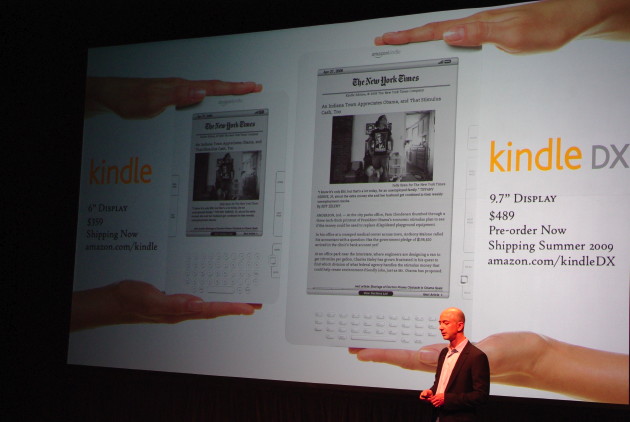Yesterday, Amazon launched its larger-format Kindle DX with a built-in PDF reader and partnership deals with textbook and newspaper companies. Today, Wall Street analysts are weighing in on what kind of impact the DX might have on Amazon’s numbers. Barclay Capital’s Doug Anmuth estimates that the DX alone could add $800 million in revenues and $100 million in gross profits in 2012. Total Kindle revenues in that year for both the smaller Kindle 2 and the Kindle DX will be be $3.7 billion, he estimates, with gross profits of $840 million. In three years time, he thinks the Kindle will represent more than 10 percent of both Amazon’s sales and gross profits (for perspective, last year Amazon reported $19 billion in sales and $4.3 billion in gross profits).
Meanwhile, Citi analyst Mark Mahaney for now is sticking with his 2010 projection of $1.2 billion in Kindle sales, which would account for over 4 percent of the total—that is next year. Mahaney isn’t going out further than that yet, but he may soon “up that estimate a bit,” he wrote in a note this morning. Why? One reason is because Amazon CEO Jeff Bezos threw out a tantalizing detail yesterday about the Kindle’s growing traction: For the books available on the Kindle, unit sales are tracking at 35 percent the level of the same titles in print, up from 13 percent in February.
Mahaney estimates that the Kindle already accounts for “about 10% of total North American book units,” or or 4 million books sold during the first quarter out of a total of 38 million books, he tells me. Those 4 million Kindle books equated to an estimated $34 million in revenues during the quarter (which doesn’t include sales of the Kindle device itself) and added 2 to 3 percent to Amazon’s growth in media revenues for North America. Mahaney also thinks that the 35 percent sales figure suggests that Kindle owners are buying two books per month on the Kindle.
Obviously, these are hardcore book readers, and that level of sales won’t stay so high as the Kindle is used by more and more people beyond the early adopters (who in this case are tech-savvy bookworms). But the Kindle DX hints at a broader strategy. It is purpose built for the educational market—students who don’t want to lug around heavy textbooks and can buy cheaper versions on the Kindle. (What would be really interesting would be a textbook subscription that gives students access to all of their books each semester, with an upgrade option to buy chapters or entire books if they want to keep them beyond that time period. But I digress).
Surely, the Kindle DX is not the last Kindle in the pipeline. Amazon will keep rolling out upgrades and offshoots designed to appeal to different readers. For instance, the DX isn’t perfect for magazines and newspapers. You really want a color screen for anything with photos and illustrations. But electronic ink technology is moving in that direction, and then there is the prospect of a larger iPod Touch that would be perfect as both a Web tablet and an electronic reader.
Already, Amazon has a Kindle app for the iPhone/iPod Touch. Despite the small size, I prefer it to the still-clunky Kindle just because I carry my iPhone with me all the time. I’d much rather read a book on an IPod Tablet than on a Kindle DX. And you know what? Amazon doesn’t care because it is not in this to sell Kindles. It is in this to sell digital books, which have much higher margins than either paper books or the Kindle devices. Amazon could (and should) just as easily make a Kindle app for Android (especially with Android Netbooks coming out), Blackberry, Palm, and Windows Mobile.
So how big can the Kindle get? It’s not about the device, it’s about the software. The only limit to how big it can get is the speed with which people can become comfortable reading books on screens.
